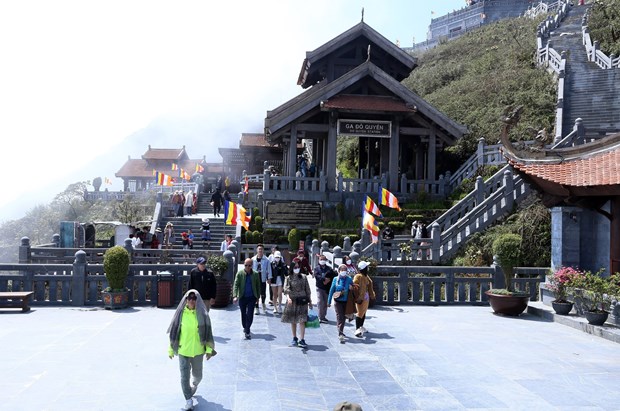 Opinion
Opinion

Phan Đăng Toàn, secretary of the Sa Pa Town Party Committee, spoke to Lao Động (Labour) newspaper about the development of Sa Pa as a green, clean, and beautiful destination.
 |
| Phan Đăng Toàn, secretary of the Sa Pa Town Party Committee. — Photo tapchicongthuong.vn |
Sa Pa leaders visited well-known localities such as Đà Nẵng, Huế, Đà Lạt to learn about their tourism practices. What were your experiences and what lessons did you learn from them?
Indeed, we have organised field trips to learn from the experiences of other cities. We realised that Sa Pa has great natural advantages that have not been fully utilised.
We also recognised that the local service industry, including accommodation and restaurants in Sa Pa, has reached a professional level. We can cater to different culinary preferences, both European or Asian tourists. Local cuisine is also very good.
However, the biggest disadvantage of Sa Pa is its poor traffic culture. Taxis and drivers in other localities can engage in conversations with tourists as tour guides, but in Sa Pa, this is not yet common.
After discussions, we have assigned the Department of Culture and the Tourism Association to organise training courses for taxi and electric vehicle drivers. We hope that in the future, they will be able to communicate in foreign languages like tour guides, introducing tourists to Sa Pa naturally and skillfully.
As for the awareness of the locals, it is generally good. However, there are still occasional incidents of clinging, street vendors and begging, which have reduced but can still be encountered easily.
The scenery of Sa Pa is truly beautiful. However, besides the stone church and the tower on the top of Mount Fansipan, there is still a lack of iconic architectural structures.
In the near future, Sa Pa will construct a tourist park. It will feature sculptures that reflect the distinctive characteristics of the northwest mountain region, such as a couple playing the trumpet, the Piêu scarf, and agricultural tools used by people in the highlands. It will undoubtedly become an interesting check-in location for tourists.
What is your assessment of existing issues in Sa Pa?
I don't hesitate to admit that Sa Pa is still messy. The houses and buildings lack architectural coherence. At night, Sapa becomes a medley of various lights, resembling a ‘hotpot’. The lights from signboards, restaurants, street lamps, and more are all excessively bright.
Traffic still experiences congestion and disorderly stops. The authorities have conducted numerous awareness raising campaigns and taken enforcement measures, but the problem has not been completely resolved.
There are multiple factors contributing to these issues, but the main issue is due to the small size of the central area, narrow streets, a high number of vehicles, and a concentration of tourists during peak times. Besides the efforts of the local government, Sa Pa hopes for greater awareness and participation from both residents and visitors regarding traffic management.
I provide this evidence so that everyone can understand the problem of Sa Pa.
In 2003, Sa Pa received just over 70,000 visitors. Ten years later, in 2013, the number was nearly 800,000. At that time, due to a severe lack of accommodation, some tourists even had to spend the night in classrooms.
By 2019 (before the COVID-19 pandemic), the number skyrocketed to 3.2 million visitors, while the central area of Sa Pa remained small. The rapid and intense development has led to the mentioned disorder. Restoring order and proper planning will take time, and that is also our responsibility.
What measures has Sa Pa implemented to minimise this problem?
We have also looked into the models of European countries. They have many narrow and small cities, but their transportation planning is very scientific, and the awareness of the residents is high, resulting in smooth traffic flow. It's worth learning from them. Therefore, Sa Pa is determined to implement static parking lots and eventually relocate all bus stations outside of the town.
Sa Pa has planned three parking areas, which will help distribute the flow of vehicles into the town. On weekends, vehicles with more than 16 seats will not be allowed into the town centre.
Currently, Sa Pa has identified 19 areas with congestion risks. We have deployed functional forces to provide guidance and contribute to congestion prevention. Additionally, traffic segregation plans have also been implemented, showing initial effectiveness.
Regarding issues of begging and hawkers, after extensive awareness campaigns, Sa Pa has begun to take stricter measures, including imposing administrative fines. The subjects of these fines are adults who exploit children to engage in street vending or begging activities.
Recently, a local resident was fined VNĐ22 million (US$929) for forcing her two young children to hawk and beg on the streets of Sa Pa.
This measure is not aimed at collecting fines, but to remind people that if they continue to commit mistakes, they may face criminal penalties. It has started to show very positive results.
With these efforts, tourists will witness a different side of Sa Pa - a much more positive one.
 |
| Tourists visit Mount Fansipan. — VNA/VNS Photo Quốc Khánh |
3.2 million visitors is a remarkable number. Have you ever considered selecting tourists and targeting Sa Pa towards high-end tourism to maximise profits?
As a national tourist destination, Sa Pa does not discriminate against any particular group of tourists. We understand that Sa Pa belongs to everyone. Whoever comes here, from ordinary people to upper-class guests, Sa Pa will welcome them with utmost hospitality.
In 2020, Sapa accepted to give up the source of income from two toll booths located at Mường Hoa and Tả Phìn communes by removing them to make it easier for local residents to access tourism services in the villages and to promote community-based tourism.
Of course, as the country's economy develops, people's demands also increase, along with an increase in middle and high-end tourists. Therefore, since 2020, Sa Pa has set a standard of 4-star or higher for resort and hotel projects.
Currently, in one night, Sa Pa can serve accommodation for 40,000 people. The target for 2025 is to maintain a stable number of visitors ranging from 3.2 million to 3.5 million per year. Later, with the completion of other resort projects, an additional 15,000 people can be served daily.
People have said that Sa Pa is gradually losing its pristine beauty, which leads some tourists to choose Hà Giang instead of Sa Pa. What do you think?
Sa Pa still has many pristine places with wonderful landscapes that tourists may not be aware of. In the outskirts, there are several tourism development projects that aim to preserve nature to the maximum extent in order to serve adventurous tourists. These places are truly beautiful.
If tourists choose Hà Giang over Sa Pa for any reason, we congratulate the neighbouring province. It's all part of our country. I'm glad to hear that. — VNS




